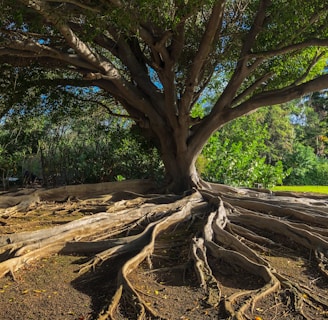The Impact of Climate Change on Ecosystems: Insights from Environmental Biology
Explore how climate change is reshaping ecosystems around the world through the lens of environmental biology. This post delves into shifting species patterns, habitat loss, and the broader ecological consequences of a warming planet.
6/9/20255 min ler


Understanding Climate Change: Causes and Consequences
Climate change refers to the significant alterations in temperature, precipitation patterns, and other atmospheric conditions over extended periods. The primary drivers of climate change are often linked to human activities that exacerbate the natural greenhouse effect, including the emission of greenhouse gases, widespread deforestation, and various industrial processes. Carbon dioxide and methane are two principal greenhouse gases that trap heat in the atmosphere, leading to a gradual increase in global temperatures.
The burning of fossil fuels—such as coal, oil, and natural gas—plays a dominant role in greenhouse gas emissions, significantly contributing to climate change. Vehicles, factories, and power plants are bastions of these emissions, releasing vast quantities of these gases into the atmosphere. Deforestation, another critical factor, not only reduces the number of trees available to absorb carbon dioxide but also releases stored carbon back into the atmosphere, accelerating the warming process.
The consequences of climate change are profound and multifaceted, leading to an increase in global average temperatures, shifts in weather patterns, and alterations in oceanic systems. Higher global temperatures contribute to the melting of polar ice caps and glaciers, resulting in rising sea levels that threaten coastal ecosystems and human settlements. Moreover, the changing weather patterns bring about intensified heatwaves, prolonged droughts, and more severe storms, fundamentally altering regional climates and disrupting local ecosystems.
On a larger scale, these changes affect ocean currents and marine ecosystems, leading to coral bleaching and shifts in fish populations, which ultimately impact global food security. The interaction between climate change and ecosystems underscores the need for urgent action. Understanding the causes and consequences of climate change is crucial in addressing its impacts on the natural world and promoting sustainable environmental practices. Addressing the factors driving climate change can help mitigate its threats to ecosystems globally and foster resilience against future environmental challenges.
Ecosystem Responses to Climate Change
Climate change significantly affects various ecosystems, prompting shifts in species distribution, alterations in reproductive cycles, and changes in food web dynamics. Terrestrial, aquatic, and marine ecosystems all demonstrate distinct responses influenced by rising temperatures, fluctuating precipitation patterns, and ocean acidification. For instance, research has shown that many species are migrating towards higher elevations or latitudes in response to increasing global temperatures. This shift can disrupt established ecological interactions, as new species encounter native populations, potentially leading to competition for resources.
In aquatic environments, freshwater ecosystems are particularly vulnerable to climate change. Increased water temperatures can lead to altered reproductive cycles among fish and other aquatic organisms, impacting population dynamics and biodiversity. Furthermore, shifts in the timing of seasonal events, such as flowering in plants or spawning among fish, can jeopardize the synchronization essential for successful reproduction. These changes not only affect the species directly involved but also the organisms that depend on them, cascading throughout the food web.
Marine ecosystems, most notably coral reefs, illustrate the dramatic impacts of climate change. Rising ocean temperatures and increased CO2 levels lead to coral bleaching, impairing the important relationships between coral and the myriad of marine species that rely on these ecosystems for habitat and food. The degradation of coral reefs diminishes their ability to provide crucial ecosystem services such as coastal protection, which affects not only marine life but also human communities dependent on fishing and tourism.
Polar environments, too, are experiencing profound changes due to climate change. The melting of polar ice diminishes habitat for species like polar bears and seals, while also altering the entire ecological balance. These shifts can disrupt food availability, leading to further decline in population numbers. As ecosystems worldwide undergo these transformations, their ability to provide essential services—such as clean air and water, carbon storage, and biodiversity support—becomes increasingly compromised.
Biodiversity and Climate Change: Challenges and Opportunities
Biodiversity serves as a crucial element in maintaining ecosystem stability and resilience. However, the impacts of climate change pose significant challenges to the integrity of various ecosystems, leading to threats such as species extinction, habitat loss, and the proliferation of invasive species. As global temperatures rise and weather patterns shift, many organisms find themselves unable to adapt or relocate, resulting in the declining populations of vulnerable species. This situation is further aggravated by habitat degradation, which diminishes the ecological niches available for wildlife.
In addition to these challenges, climate change accelerates the spread of invasive species. Warmer temperatures and altered precipitation patterns create conducive environments for non-native species to thrive, often outcompeting local flora and fauna. This shift can disrupt existing ecological balances, making it increasingly difficult for native species to survive. As such, understanding the interrelationship between biodiversity and climate change is fundamental to developing effective conservation strategies aimed at mitigating these effects.
Despite these challenges, there are opportunities within the realm of conservation strategies that can help safeguard biodiversity. Restoration ecology has emerged as a promising field, focusing on rehabilitating degraded ecosystems and reintroducing native species. Successful case studies, such as the restoration of wetland habitats, demonstrate how targeted approaches can revitalize ecosystems while promoting biodiversity. Furthermore, implementing adaptive management strategies is essential, as it allows for flexible responses to changing conditions, ensuring that conservation efforts remain effective over time.
Emphasizing the importance of protecting biodiversity is paramount for the resilience of ecosystems facing climate change. Strategies that incorporate habitat protection, species conservation, and community involvement are critical for fostering biodiversity. By recognizing the intricate connections between climate change and ecosystems, society can develop informed policies that promote sustainable outcomes for both wildlife and human communities alike.
The Future of Ecosystems in a Changing Climate
Addressing the challenges presented by climate change on ecosystems necessitates a multi-faceted approach encompassing mitigation and adaptation strategies. Among these strategies, sustainability practices play a pivotal role in reducing the negative impacts of human activities, thereby fostering ecosystems that are more resilient to climatic fluctuations. Sustainable agriculture, for instance, can minimize land degradation and enhance biodiversity, crucial factors for maintaining ecosystem stability.
Reforestation is another essential strategy aimed at combating climate change. By restoring forests, carbon sequestration occurs, which is vital for reducing greenhouse gas levels in the atmosphere. Trees not only absorb carbon dioxide but also provide habitat for various species, enhance soil quality, and regulate water cycles. Initiatives that support afforestation and reforestation can greatly contribute to ecosystem recovery and resilience.
Community-based adaptation strategies also play a significant role in enhancing ecosystem resilience. Involving local communities in decision-making processes regarding the management of natural resources ensures that cultural knowledge is incorporated, fostering strategies that align with local needs. Education and capacity building empower communities to develop sustainable practices tailored to their unique environments, thereby promoting ecological health.
Moreover, effective policy-making is central to the implementation of these strategies. Governments must create and enforce policies that support sustainability, incentivize reforestation, and promote local adaptation efforts. Collaboration between scientists, policymakers, and community leaders can enhance the effectiveness of these initiatives. Scientific research further contributes to understanding the intricate dynamics of ecosystems and climate interactions, providing valuable insights for developing targeted strategies.
By embracing a combination of these approaches, we can cultivate a future where ecosystems are more resilient to the unprecedented changes wrought by climate change. Engaging in proactive measures will not only safeguard biodiversity but also ensure that ecosystems continue to provide essential services that support life on Earth.
Explore
Discover the wonders of life sciences today.
Learn
Engage
contact@bioversexplore.com
© 2025. All rights reserved.
